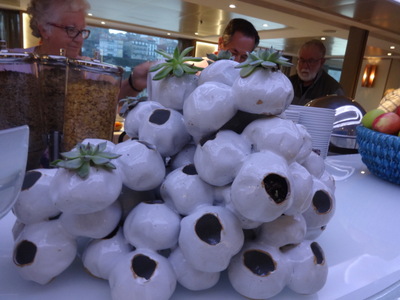
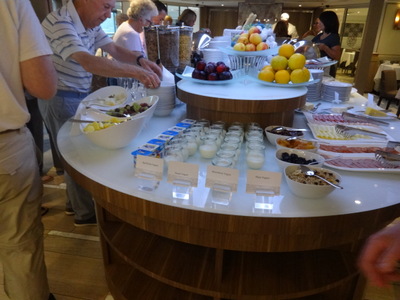 For early risers, continental breakfast was available from 6 a.m. at the coffee station, but the "real" breakfast buffet opened at 7 a.m.
For early risers, continental breakfast was available from 6 a.m. at the coffee station, but the "real" breakfast buffet opened at 7 a.m. Monday, 24 August 2015: Touring Porto, Porto to Bitetos
Written 24 November 2015

 For early risers, continental breakfast was available from 6 a.m. at the coffee station, but the "real" breakfast buffet opened at 7 a.m.
For early risers, continental breakfast was available from 6 a.m. at the coffee station, but the "real" breakfast buffet opened at 7 a.m.
This wonderful planter served throughout the cruise as a centerpiece for the buffet. We never decided whether its little white cups were intended to be sea-urchin tests, puff-ball mushrooms, or something else entirely, but I really liked the effect, especially with little succulent plants in some of the cups. At breakfast, it was always surrounded by bowls of whole fresh fruit.
In Lisbon, the bacon was outstanding and the scrambled eggs were dreadful. On the Hemming, the opposite was the case—the scrambled eggs were delicious, but the bacon was awful. The sausages were also not such a much and the mushrooms were undercooked (though still delicious). I didn't try the tomatoes, because so many other wonderful choices were available.
In the photo, you can see the yogurt selection—a few flavors of Danon, plus fresh yogurt made on board and served plain or flavored with red-fruit, peach, or strawberry jam (the jams were also made on board), accompanied by granola and several flavors of dried fruit. To the right is a selection of cold cuts and sliced cheeses, and beyond those the smoked salmon, real cream cheese, capers, onions, sliced, tomato, and chunks of three local cheeses (rabaçal; queijo de Ilha, which I took to mean "island cheese"; and "Quinta dos Ingleses," meaning "English port-wine estate"). To the left are big bowls of cut fruit (note the ever-present white-fleshed melon), dispensers with several cold cereals, and beyond that muesli (actually prepared as directed on the package—mixed with yogurt and chopped fresh apple), hot oatmeal, bagels, sliced bread and toaster, jams and honey, several kinds of breakfast pastry, and (for the Americans, I guess), peanut butter and a plate of doughnuts with chocolate or pink icing and candy sprinkles! Finally, in the back, the chef stood by to make omelets or otherwise cook eggs to order. I never had my eggs cooked to order, because the scrambled eggs on the buffet were so uniformly good.
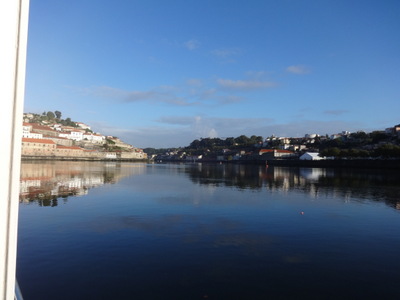
 Here are a couple of views from our mooring at Porto. At the left is the view from our balcony looking downriver toward the Atlantic (which itself is out of sight). The right-hand bank is the outskirts of Porto proper; the right-hand bank is Vila Nova de Gaia, where the port lodges and our mooring are located.
Here are a couple of views from our mooring at Porto. At the left is the view from our balcony looking downriver toward the Atlantic (which itself is out of sight). The right-hand bank is the outskirts of Porto proper; the right-hand bank is Vila Nova de Gaia, where the port lodges and our mooring are located.
The photo at the right shows the 18th-century bishop's palace in Porto, viewed from across the river. The two towers beyond it are the much earlier cathedral. The row of narrow houses on the water front form the center of night-life in Porto. In the evening, throngs of people strolled back and forth in front of the brightly lit shops and restaurants, people fished off the quais, and we could hear dance music all the way to the ship.
The medieval city occupied two hills—the one with the bishop's palace and the one to the left of it (viewed from the quai)—plus the riverside. Everything was built of granite (which is also exported widely); in the southern part of the country, they built in limestone.
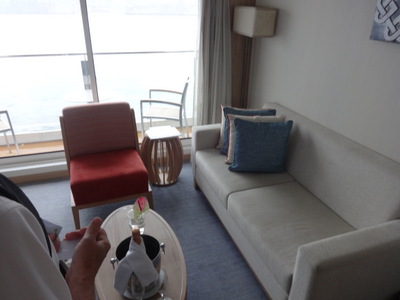
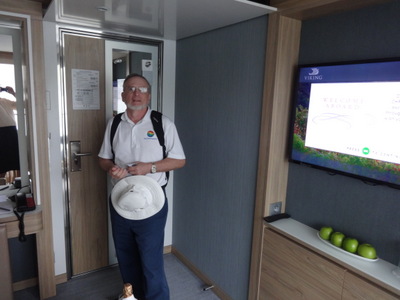 At the left here is a view of the sitting room of our suite, with the bottle of champagne on the coffee table and the balcony with table and chairs beyond. The photo on the right is the same room, facing the other way, showing the big-screen TV (which we never used).
At the left here is a view of the sitting room of our suite, with the bottle of champagne on the coffee table and the balcony with table and chairs beyond. The photo on the right is the same room, facing the other way, showing the big-screen TV (which we never used).
At the left-hand edge of the photo, you can see a bit of the writing desk/vanity, with a mirror above it (you can even see a slice of me, in a yellow shirt and black skirt, as I take the photo). On that desk sat the charger for our Quietvoxes. In Lisbon, the Quietvoxes were collected each day and issued again in the morning. On the ship, we were each issued one that we kept for the whole week; whenever they weren't in use, they sat in their little charging station.
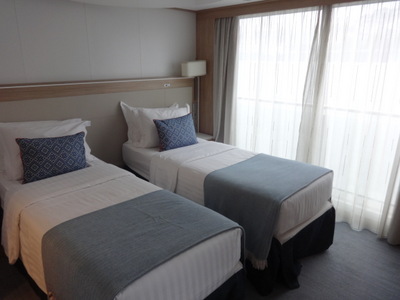
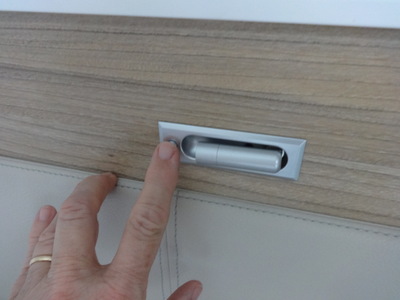 At the left here is a view of the bedroom of our suite, with its "French balcony" beyond. I was curious to learn what a "French balcony" was; it turns out to be a sliding glass door with nothing outside it except for a low railing to stop you from stepping through. To my left as I took this photo was the bathroom, with quite a large shower stall. Weve had much smaller and less convenient accommodation in many a hotel!
At the left here is a view of the bedroom of our suite, with its "French balcony" beyond. I was curious to learn what a "French balcony" was; it turns out to be a sliding glass door with nothing outside it except for a low railing to stop you from stepping through. To my left as I took this photo was the bathroom, with quite a large shower stall. Weve had much smaller and less convenient accommodation in many a hotel!
At the head of each bed (we chose the twin option, but double beds are also available) was one of these tiny but very bright LED reading lamps. The button turns it on and off, and the cylinder swings out of its slot and can be angled as you please.
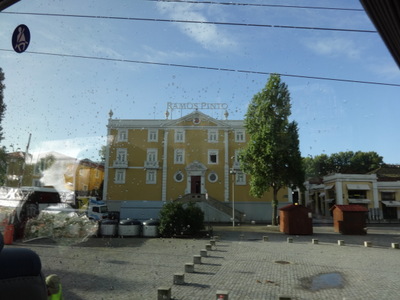
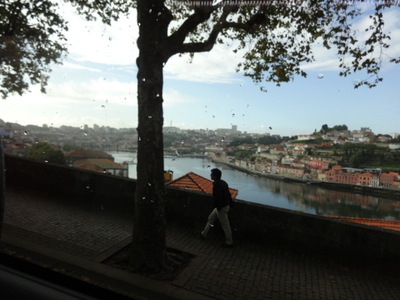 After breakfast, we went back to the stateroom for our hats and our Quietvoxes and boarded the bus for the morning's tour of Porto. The first sight of interest was the façade of the Ramos Pinto port lodge, located right on the riverside near our mooring.
After breakfast, we went back to the stateroom for our hats and our Quietvoxes and boarded the bus for the morning's tour of Porto. The first sight of interest was the façade of the Ramos Pinto port lodge, located right on the riverside near our mooring.
To get the the city, our bus switchbacked up the steep south bank of the river, affording us views over the city (like the one shown here at the right) with every turn. It had rained a little during breakfast, so my photos through the bus windows are dotted with water droplets.
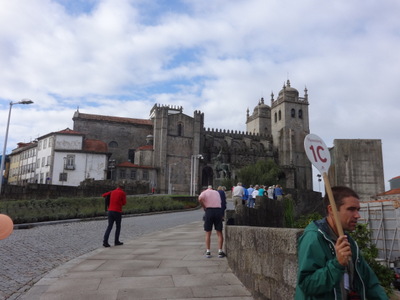
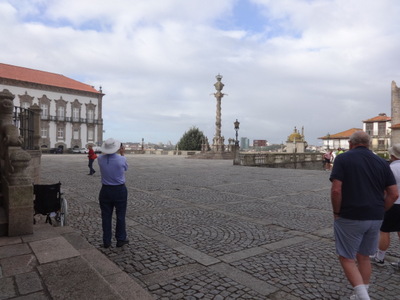 Then we drove over the bridge, high above the river, to visit the cathedral. The buses couldn't go all the way up to the building, so we were dropped off here to walk up to it. At the lower right in the left-hand photo is Henry (probably actually Henrique or some such), our tour escort, carrying the inevitable 1C lollipop around which we bus-C denizens always rallied. Henry replaced our Lisbon tour escort when we reached Porto and stayed with us in Bus C throughout the week, sometimes acting as tour guide himself and others accompanying us while a local guide showed us the sights.
Then we drove over the bridge, high above the river, to visit the cathedral. The buses couldn't go all the way up to the building, so we were dropped off here to walk up to it. At the lower right in the left-hand photo is Henry (probably actually Henrique or some such), our tour escort, carrying the inevitable 1C lollipop around which we bus-C denizens always rallied. Henry replaced our Lisbon tour escort when we reached Porto and stayed with us in Bus C throughout the week, sometimes acting as tour guide himself and others accompanying us while a local guide showed us the sights.
I was quite impressed with how careful the Viking folks were to brief us fully in advance about conditions on each of the excursions—how far we would walk, whether we would go up or down stairs, etc. That way, anybody with mobility issues knew whether to bring the wheel chair or a cane or walker would do. They were very, very accommodating of anyone with such problems. For example, one guest who needed a wheel chair on some days was taken the long way around in a taxi by one of the tour escorts to meet the group for a tour that started where the bus couldn't go.
The photo at the right shows David lining up his photo of an object in the plaza in of the cathedral that I initially took to be a calvary but which turned out to be the old medieval city pillory. Beyond the far parapet and the corner of the white bishop's palace you can look out and down over the river.
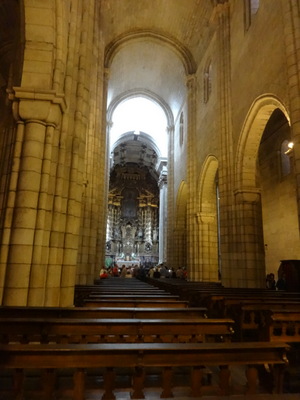
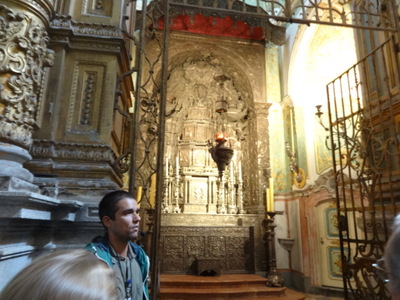 The cathedral was originally built in the 12th century in the romanesque style (note the round arches in the nave, in the left photo). Gothic and baroque decoration was added later. The windows are very small, but the crossing of the transept, redone in the 13th century allows more light to enter. In the 18th and 19th centuries, the round apse was made rectangular, and the deambulatory behind the altar was eliminated. The new altar is gilded exotic wood, which became very popular when all those new exotic woods became available with the discovery and exploitation of Brazil. An Italian working in Porto painted the walls of the main chapel in 1735. His altar piece became the model for others in town and elsewhere in the north of Portugal.
The cathedral was originally built in the 12th century in the romanesque style (note the round arches in the nave, in the left photo). Gothic and baroque decoration was added later. The windows are very small, but the crossing of the transept, redone in the 13th century allows more light to enter. In the 18th and 19th centuries, the round apse was made rectangular, and the deambulatory behind the altar was eliminated. The new altar is gilded exotic wood, which became very popular when all those new exotic woods became available with the discovery and exploitation of Brazil. An Italian working in Porto painted the walls of the main chapel in 1735. His altar piece became the model for others in town and elsewhere in the north of Portugal.
The photo at a the right is the famous 17th century silver altar, in a secondary chapel to the left of the main one. It is formed of more than 500 kg of solid silver (also from Brazil). When the French invaded, the locals plastered over the silver altar, and the French never found it (the story was thought apocryphal until a recent cleaning of the surface discovered bits of paster in all the crevices). It portrays Our Lady with the Child, the patron saint of Porto.
The cathedral is on the road from Lisbon to Santiago de Compostela (about 220 miles), though the way is sometimes only marked with painted yellow arrows. Blue arrows point to Fatima.
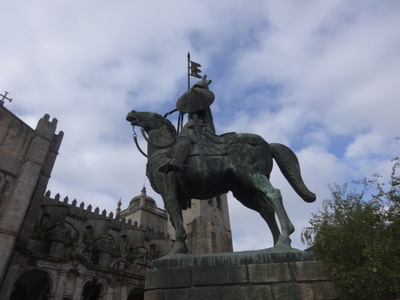 This equestrian statue at the top of the slope up to the cathedral is of Vimara Peres (born 868 AD), the first count of Portucale. Portus was the port, down on the river bank, and Cale was the village on the hill (where the cathedral is now); together they were called Portucale, the name that became "Portugal."
This equestrian statue at the top of the slope up to the cathedral is of Vimara Peres (born 868 AD), the first count of Portucale. Portus was the port, down on the river bank, and Cale was the village on the hill (where the cathedral is now); together they were called Portucale, the name that became "Portugal."
Henry the Navigator was born in Porto in 1394. His parents were John I of Portugal and Phillipa of Lancaster (who were married in 1388 in the cathedral). The Thursday before we visited (19 August) was the 500th anniversary of Portugal's first overseas conquest (by Henry the Navigator in north Africa). It turns out that Henry didn't actually do a lot of navigating himself, but he strongly encouraged navigation, sending explorers all over the world to claim territories for Portugal, with the result that the country soon became one of the richest and most powerful in the world. The riches derived from Brazil alone were enormous—we saw evidence of them wherever we went. In Porto's main square, in front of the Cork Exchange and St. Francis Church, is a statue of Henry pointing south (i.e., toward the overseas conquests.
After touring the cathedral, we were led on a short walking tour of parts of the city, cleverly arranged to be mostly downhill. We passed the Clerigos Tower, a baroque building, the tallest tower in Porto. We admired the exterior but did not climb the 260 steps to the top.
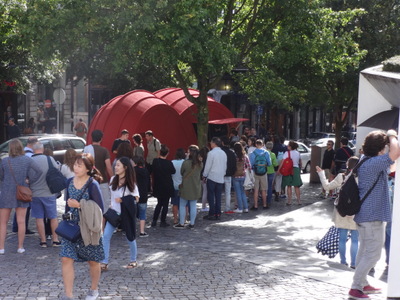
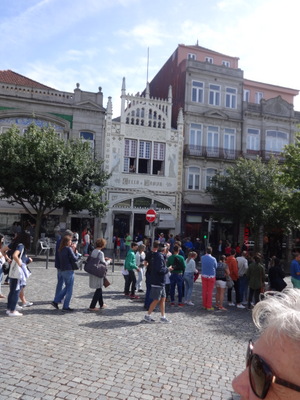 One of the sights on the walk was this quaint little structure in the shape of a couple of giant port barrels (in fact, it may have been constructed from a couple of port barrels). It is, believe it or not, the box office for the Lello Bookstore, the narrow little building with the baroque façade shown in the right-hand photo.
One of the sights on the walk was this quaint little structure in the shape of a couple of giant port barrels (in fact, it may have been constructed from a couple of port barrels). It is, believe it or not, the box office for the Lello Bookstore, the narrow little building with the baroque façade shown in the right-hand photo.
Yes, the bookstore is so famous for the beauty of its interior—it's billed as the world's most popular—that they actually charge admission to keep the crowds down. If you buy something, the admission price is subtracted from the item price. The pictures I've seen are indeed stunning (just Google for lots of images), but we didn't go in.
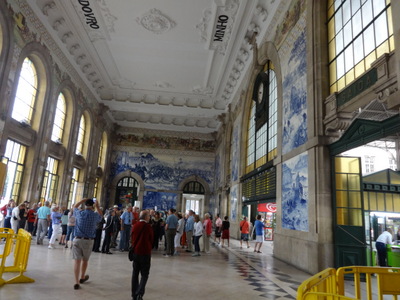
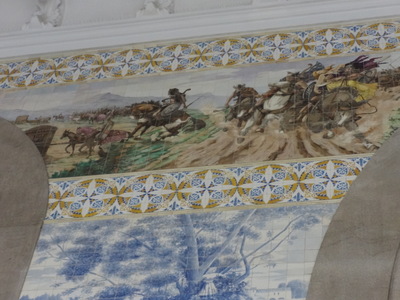 Another stop was the main train station, Sao Bento (St. Benedict's), so named because it was (like so many other public buildings in Portugal) an old monastary. Its façade was designed by a student of the guy who built the Gare d'Orsay in Paris, and you can see the influence. Work on the station began in 1900, and its lobby is decorated, beginning in 1905, with more than 20,000 glazed tiles by Jorge Colaço. The large scenes are done in the traditional Chinese-influenced blue and white, but around the top, just under the ceiling, is a colorful frieze depicting all sorts of modes of transportation, from Roman chariots to the advent of the railroad. The tile artist's work also appears on church façades all over town.
Another stop was the main train station, Sao Bento (St. Benedict's), so named because it was (like so many other public buildings in Portugal) an old monastary. Its façade was designed by a student of the guy who built the Gare d'Orsay in Paris, and you can see the influence. Work on the station began in 1900, and its lobby is decorated, beginning in 1905, with more than 20,000 glazed tiles by Jorge Colaço. The large scenes are done in the traditional Chinese-influenced blue and white, but around the top, just under the ceiling, is a colorful frieze depicting all sorts of modes of transportation, from Roman chariots to the advent of the railroad. The tile artist's work also appears on church façades all over town.
Written 10 December 2016
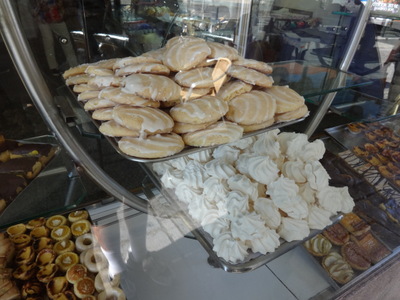
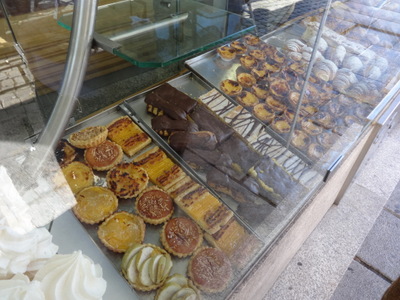 After a stroll that included several striking pieces of monumental art and a walk through the university square (which houses only the administration these days; the rest of the buildings are scattered around the city), we were turned loose to wander around on our own for a while (we visited this bakery for a completely unnecessary snack).
After a stroll that included several striking pieces of monumental art and a walk through the university square (which houses only the administration these days; the rest of the buildings are scattered around the city), we were turned loose to wander around on our own for a while (we visited this bakery for a completely unnecessary snack).
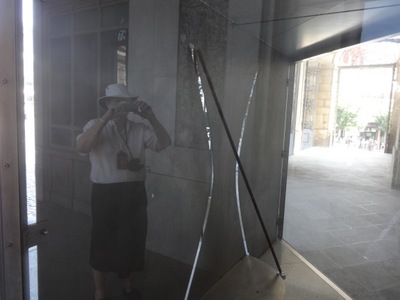
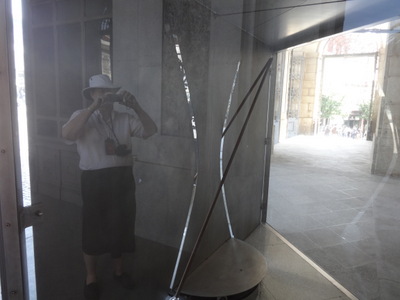 Among the items we passed by in the square in front of the main university building was a very large piece of petrified tree trunk, held upright against a wall by a metal band around its "waist," and a life-size replica of a dinosaur outside a museum, but by far the most fascinating, at least to me, was this thing (sculpture? scientific demonstration? curiosity?) called "Parabolic slit. It consisted of (a) a stationary vertical metal sheet pierced by two slots that formed a hyperbola and (b) a horizontal disk below the sheet that rotated continuously. Welded to one edge of the disk were two metal bars, separated by about 1/3 of the disk's circumference, that met and were joined at the top. They were not vertical but were slightly slanted so that the point where their top ends joined was directly above the opposite edge of the disk. At the disk turned, Those two straight, rigid bars slid magically (well, actually, with geometric inevitability, I'm sure) in and out through those parabolic slits, without ever touching the metal sheet! In both photos, you can see my reflection in the glass case enclosing the exhibit; the left-hand photo shows the apex where the bars are joined just emerging at the top of one side of the hyperbola, and the one at the right shows them headed toward the point where that point will slide back through the top of the slit on the other side. I watched it go round and round for a good 10 minutes, and I still couldn't believe it!
Among the items we passed by in the square in front of the main university building was a very large piece of petrified tree trunk, held upright against a wall by a metal band around its "waist," and a life-size replica of a dinosaur outside a museum, but by far the most fascinating, at least to me, was this thing (sculpture? scientific demonstration? curiosity?) called "Parabolic slit. It consisted of (a) a stationary vertical metal sheet pierced by two slots that formed a hyperbola and (b) a horizontal disk below the sheet that rotated continuously. Welded to one edge of the disk were two metal bars, separated by about 1/3 of the disk's circumference, that met and were joined at the top. They were not vertical but were slightly slanted so that the point where their top ends joined was directly above the opposite edge of the disk. At the disk turned, Those two straight, rigid bars slid magically (well, actually, with geometric inevitability, I'm sure) in and out through those parabolic slits, without ever touching the metal sheet! In both photos, you can see my reflection in the glass case enclosing the exhibit; the left-hand photo shows the apex where the bars are joined just emerging at the top of one side of the hyperbola, and the one at the right shows them headed toward the point where that point will slide back through the top of the slit on the other side. I watched it go round and round for a good 10 minutes, and I still couldn't believe it!
Then it was back to the bus and over the bridge to the Vila Nova de Gaia side, to visit a port lodge. All the port lodges are located on the south bank of the river, because if they had been founded on the north bank, officially in the city of Porto, they would have been taxed heavily. Now, just about the whole steep south bank is covered with them—dozens of them, many with very familiar names.
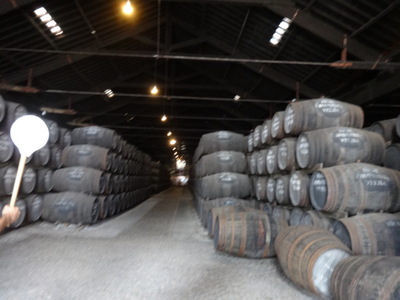
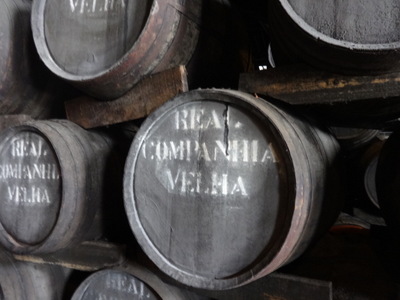 The wine that becomes port is actually made upriver, where the grapes are grown, pressed, and fermented. The grapes are harvested in the fall, the wine ferments all winter in place, and then, in the spring, it is shipped downriver to the port lodges, where it undergoes the blending and aging processes that make it into port. The place we visited was the "Real Companhia Velha," the "Royal Old Company," founded, like so many things in Portugal, by Pombal, in 1856. A great many of the port companies have English names (e.g., Taylor, Sandeman) because England was the original market for port. The English were the ones who sought out Portuguese wines as a replacement for French ones when they were at war with France in the 17th century, and they founded their own aging and bottling operations there. The city across the river is called "Porto" in Portuguese but "Oporto" in English. The latter is a conflation of two Portuguese words meaning "to Porto," as in, "Where are you bound? To Porto." I use "Porto" throughout, though.
The wine that becomes port is actually made upriver, where the grapes are grown, pressed, and fermented. The grapes are harvested in the fall, the wine ferments all winter in place, and then, in the spring, it is shipped downriver to the port lodges, where it undergoes the blending and aging processes that make it into port. The place we visited was the "Real Companhia Velha," the "Royal Old Company," founded, like so many things in Portugal, by Pombal, in 1856. A great many of the port companies have English names (e.g., Taylor, Sandeman) because England was the original market for port. The English were the ones who sought out Portuguese wines as a replacement for French ones when they were at war with France in the 17th century, and they founded their own aging and bottling operations there. The city across the river is called "Porto" in Portuguese but "Oporto" in English. The latter is a conflation of two Portuguese words meaning "to Porto," as in, "Where are you bound? To Porto." I use "Porto" throughout, though.
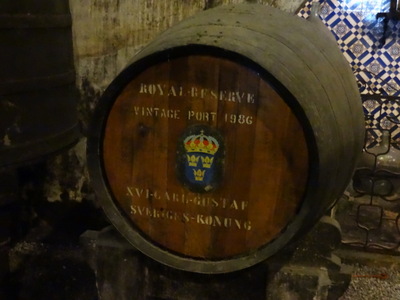
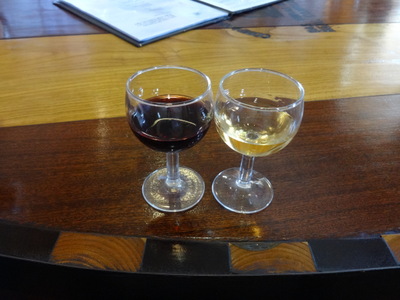 The barrel in the right-hand photo is one of several being aged specifically for the Swedish king. The barrels used come in all sizes from those large enough to house box offices to small ones called "pipes." We had always wondered what a "pipe" of port was when we read in British literature about proud fathers laying down a pipe of port at the birth of each son.
The barrel in the right-hand photo is one of several being aged specifically for the Swedish king. The barrels used come in all sizes from those large enough to house box offices to small ones called "pipes." We had always wondered what a "pipe" of port was when we read in British literature about proud fathers laying down a pipe of port at the birth of each son.
The largest barrels, which are used for the youngest wines, hold 81,000 liters (180,000+ bottles).
The right-hand photo shows the two glasses of port David was offered in the ornate tasting room at the end of the tour. The one on the left is a quite old white port, beginning to show its golden color. White port turns golden with age but is never aged long (by port standards). On the right is a four-year tawny. Red ports turn paler and dryer with age and can be aged indefinitely; 40 years is not unusual. A red port less than four years old is called "ruby"; those four years and up are "tawny." Reds aged for long periods in the barrel also picks up oak flavors. The oak barrels can be used for 70 to 100 years and are then sold to whiskey and scotch makers. Bushmills buys the ones from the lodge we visited.
Port is a "fortified wine." When the grape juice is fermented (back at the farm upriver, remember), 1 part "agua ardente" (77% alcohol distilled from wine) is added for every 4 parts. That stops fermentation (by killing the yeast, which can't take that much alcohol). This addition is made after 1, 2, or 4 days of fermentation to produce sweet, medium, or dry wines. Red ports are made from red grapes and white ones from white grapes (not necessarily the case for table wines, where white wines can be made from red grapes). For port, up to 19 red grape varieties can be used, and up to 14 white ones, though three or four principal varieties dominate the mix.
Every year, the varietal mix is different, and older ports are mixed in, so as to keep each brand's characteristic taste stable. Every few years, in a really good year, all the houses collaborate to decide to declare a vintage year and produce vintage ports, which are not blended with wines from any other year. Declaration of a vintage year takes agreement of a certain majority of the houses. In years that fall a little short, individual houses may make and bottle a sort of pseudovintage unblended port (the name escapes me for the moment), but it can't be called "vintage."
Real Companhia Velha still has some of their 1867 port, which would be 4,000 to 5,000 euros a bottle, if you could get it.
Other interesting things learned during the morning:
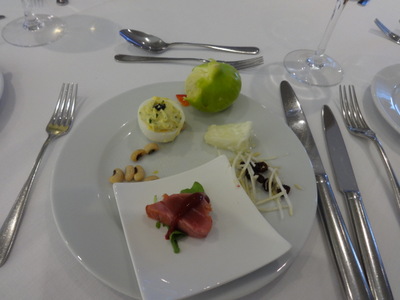
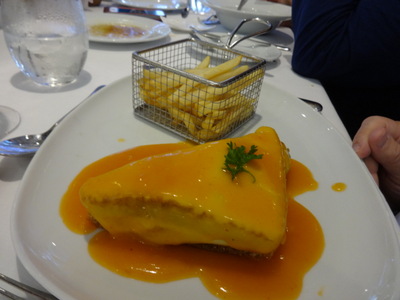 For lunch, we headed back to the ship. The appetizers choices were billed as tuna tataki and stuffed eggs (the latter a regional specialty), but in fact those were only two items on an extensive appetizer buffet. At the left is my plate. Clockwise from the top: a ripe green fig (yum!), a chunk of white melon (I was still going easy, to make sure I could digest it), shredded apple and celery root with sliced olives, a piece of the tuna, a little black-eyed pea salad, and a stuffed egg. The tuna was great. I went back for more of that and another of those great figs. While we ate our appetizers, the waiters came around to take main-course orders.
For lunch, we headed back to the ship. The appetizers choices were billed as tuna tataki and stuffed eggs (the latter a regional specialty), but in fact those were only two items on an extensive appetizer buffet. At the left is my plate. Clockwise from the top: a ripe green fig (yum!), a chunk of white melon (I was still going easy, to make sure I could digest it), shredded apple and celery root with sliced olives, a piece of the tuna, a little black-eyed pea salad, and a stuffed egg. The tuna was great. I went back for more of that and another of those great figs. While we ate our appetizers, the waiters came around to take main-course orders.
David tried the "franchesinha" (the "little frenchie"), an item that was on my list to try—it's a Portuguese specialty. It's a sandwich filled with cheese, sausage, pork, ham, steak, grilled, and then smothered in this pale creamy tomato sauce. It turned out not to be as good as it sounded.
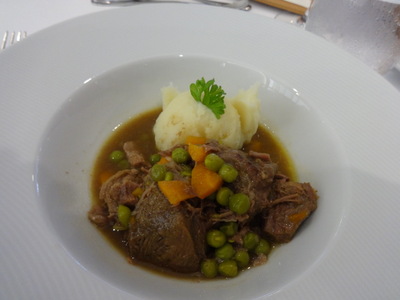
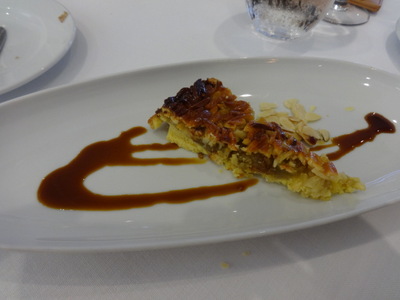 I had the tender veal stew with mashed potatoes and vegetables, and that turned out to be great!
I had the tender veal stew with mashed potatoes and vegetables, and that turned out to be great!
The other two choices were cauliflower soup with crispy bacon and olive oil and linguine with pesto, both vegetarian.
For dessert we both chose almond tart, which was sort of like a thin pecan pie but made with slivered almonds. The other choice was ice cream.
All the portions were restrained, but you could ask for seconds of anything or, for that matter, order more than one main course or dessert.
After lunch, the choices were many, though somewhat narrowed when the expedition to Guimarães (pronounced "Ghee-mah-resh") was cancelled because not enough people signed up. You could catch a Viking bus over to the city of Porto to spend the afternoon on your own, or you could stay on board and admire the view as we cruised upriver to Bitetos (where the shore party would rejoin the ship by bus), during which time you could either attend or skip afternoon tea and/or a presentation about cork.
We stayed on board. David opted for a nap. I sat in the lounge with my computer and transcripted as fast as I could. We were given so much information and saw so many interesting things that I was making up to a couple of hundred notes a day on my little recorder, and it only holds 400 total, so I typed my fingers to the bone to keep up! I listened with half an ear to the cork presentation and took a little time to look over the displays.
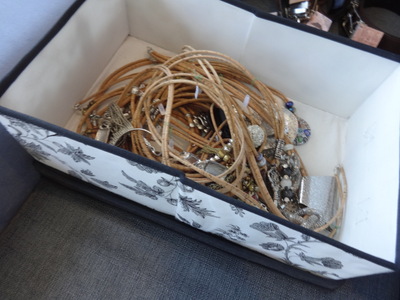
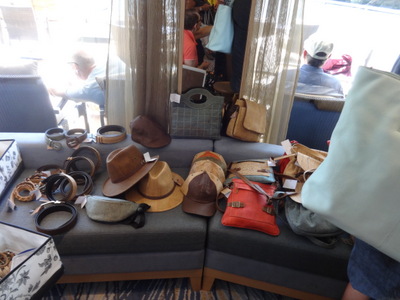 The presentation turned out to be mostly a sales pitch by a local artist/craftsperson who makes things out of cork, but it was also a promotion of the cork industry in general, which is on the increase in Portugal.
The presentation turned out to be mostly a sales pitch by a local artist/craftsperson who makes things out of cork, but it was also a promotion of the cork industry in general, which is on the increase in Portugal.
The photo at the left is of a bin filled with necklaces and bracelets, and the odd thing is that the cork part is the string from which the various metal pendants are hung! The speaker demonstrated that you can bend that strand of cork double and step on it, and it still doesn't break—it really is amazingly flexible and durable. At the right is an assortment of other stuff made entirely of thin sheets of cork—hats, caps, belts, purses, fanny packs. She emphasized that it's all waterproof and sheds stains but that it can be dyed if you know how, explaining, e.g., the bright red purses and different shades of brown. I sort of liked the hats, but I didn't buy anything. This was the only such sales pitch we were subjected to on the cruise, and it was pretty low-key and had pretty high information content.
At 4 p.m., after the cork lady, tea was served, and the pianist showed up and played easy-listening, starting with a couple of Edith Piaf songs.
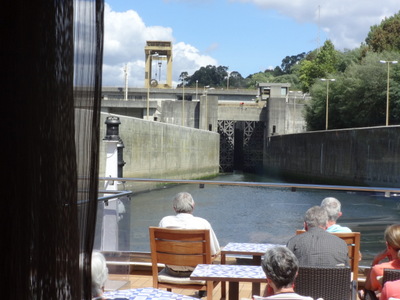
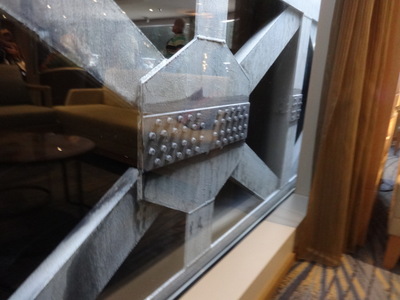 Meanwhile, we were cruising upstream and passed our first lock of the trip. Like all the locks we saw, it formed the southern end of a dam across the river. This one—the first above Porto—raised the ship about 14 m (46 ft). In this lock and all the others, the walls were clean and dry, so they must be kept habitually empty. (On the canals of France, some locks, when not in use, are kept full and others empty. You can tell the difference because mussels and algae grow on the walls of the ones kept full.)
Meanwhile, we were cruising upstream and passed our first lock of the trip. Like all the locks we saw, it formed the southern end of a dam across the river. This one—the first above Porto—raised the ship about 14 m (46 ft). In this lock and all the others, the walls were clean and dry, so they must be kept habitually empty. (On the canals of France, some locks, when not in use, are kept full and others empty. You can tell the difference because mussels and algae grow on the walls of the ones kept full.)
The photo at the left shows our approach to the downstream doors; that on the right shows how narrow the clearances were. That large iron structure is inches outside the lounge window I photographed it through, and the clearance on the other side was just as close. Entering the lock, we touched three times, but very gently. Once we were inside, structures on the inside of the lock engage the boat to keep it from bumping back and forth as it rises.
I'm told that river is from 1 to 14 meters deep, and apparently the Hemming can cruise even in the shallowest parts. Above the first lock, I spotted a few very small patches of water hyacinth, floating free and headed downstream. The plant was a little taller and narrower than what you see in Florida. I never found a larger patch that could have been the source, so if there's a real infestation, it must be above the head of navigation.
On the banks, I could see some patches of prickly pear and some clumps of ailanthus, and I spotted several ducks (mallards?) and several "hérons cendrés" (ashy herons, the European counterpart to the great blue). At one point, I saw a gray bird on the bank, mockingbird size and shape—a thrush, maybe—and a flock of starlings (the same ones we have; they came over from Europe).
The banks bore more conifers, though I still sawsome eucalyptus and patches of cane. A few white-breasted swallows were flying around. A lovely terraced estate on the river had was surrounded by terraces with lots of citrus, apple, and pear trees, easily identified through binoculars, as they were laden with fruit.
Written 12 December 2015
More interesting info. (I'm telling you; they lectured us constantly, whenever we were on the way somewhere. It was great. We learned a ton of stuff, and we never felt as though the transit times were wasted.)
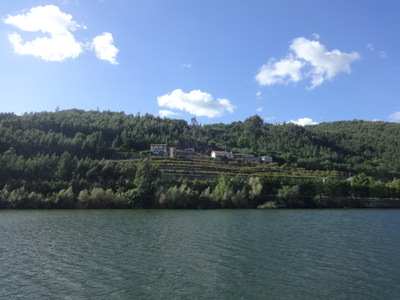
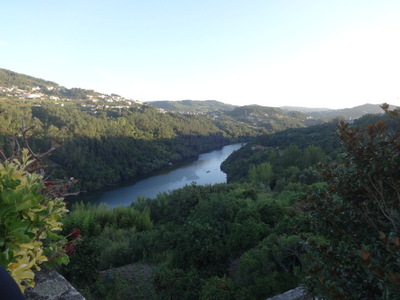 The evening's dinner was to be at an 11th century monastary turned hotel, so we once again boarded the buses for another spectacular series of views as we climbed the steep river bank to the hills above. Every time we left the ship, we were to stop by reception and pick up our landing cards. These were little business-card-sized items with our names and the Viking logo on one side and the ship's contact information on the other. They served the dual purpose of helping the crew keep track of who was aboard and who wasn't and of helping anybody who got lost, injured, or otherwise in distress to contact the ship for help.
The evening's dinner was to be at an 11th century monastary turned hotel, so we once again boarded the buses for another spectacular series of views as we climbed the steep river bank to the hills above. Every time we left the ship, we were to stop by reception and pick up our landing cards. These were little business-card-sized items with our names and the Viking logo on one side and the ship's contact information on the other. They served the dual purpose of helping the crew keep track of who was aboard and who wasn't and of helping anybody who got lost, injured, or otherwise in distress to contact the ship for help.
As usual, Henry the tour escort plied us with useful and interesting information on the way. Always trying to improve his English vocabulary, he tried to come up with a new C word to describe us and bus C every time boarded; once we were "charismatic," and at other times "colossal" or "cheerful." By the end of the week, I think we were even "cataclismic" once.
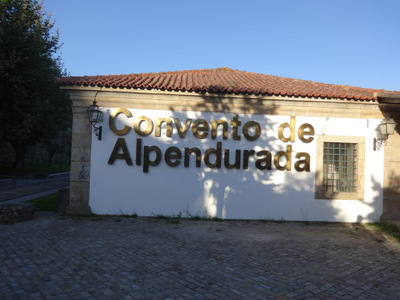
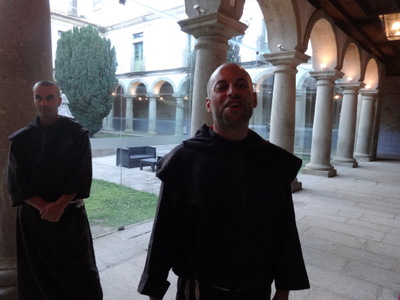 At the left here is the name of the dinner venue, the Convento de Alpendurada. The building dates from 1058 A.D. and is perched on a hillside high above the river and did not seem to be especially busy when we were there; it was pretty late in the season, after all. To continue the monastary theme, all the staff are dressed as monks.
At the left here is the name of the dinner venue, the Convento de Alpendurada. The building dates from 1058 A.D. and is perched on a hillside high above the river and did not seem to be especially busy when we were there; it was pretty late in the season, after all. To continue the monastary theme, all the staff are dressed as monks.
At the right here is our own ship-board maitre d', Claudio, dressed up to match, greeting us at the door in the cloister. He had gone on ahead to ensure that, when dinner was served, everyone on a special diet was served appropriately.
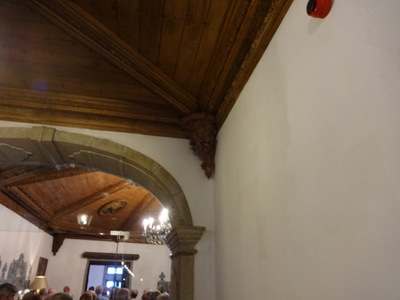
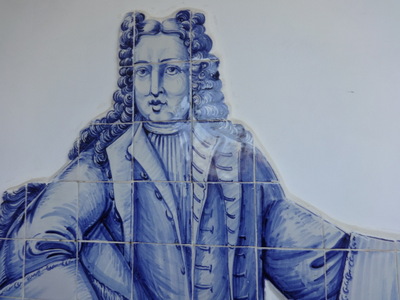 On the way to the dining room, in a vaulted stone room, we were given a brief tour of some of the public areas of the building. The photo on the left gives a partial view of some of the elaborately constructed chestnut ceilings. Chestnut apparently repels insects, so such ceilings often survive for centuries, as these have.
On the way to the dining room, in a vaulted stone room, we were given a brief tour of some of the public areas of the building. The photo on the left gives a partial view of some of the elaborately constructed chestnut ceilings. Chestnut apparently repels insects, so such ceilings often survive for centuries, as these have.
At the right is a detail from one of the many panels of blue-and-white glazed tiles we passed. Those, of course, are much more recent.
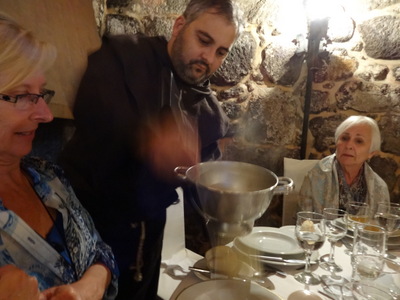
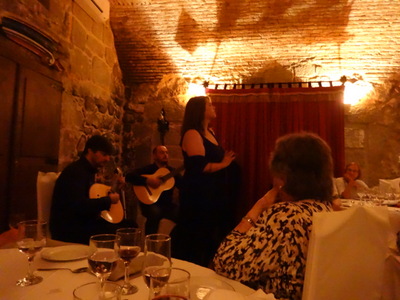 The first course was one of Portugal's traditional soups, a broth with beans and vegetables, slightly thicked by the starch from a few mashed beans. A "monk" served each of us from a large metal tureen.
The first course was one of Portugal's traditional soups, a broth with beans and vegetables, slightly thicked by the starch from a few mashed beans. A "monk" served each of us from a large metal tureen.
I'm pretty sure there was a second course, but I didn't get a photo and now I can't remember what it was. Between courses, we were entertained by a concert of Lisbon-style fado. Again, the group included a Spanish guitar and a Portuguese guitar, but this time, the vocalist was female. Kathy, who is a connaisseur of fado, agreed with me that they were very good, especially the singer. Above the singer's head, note the thin flat clay bricks that form the vaulted ceilings.
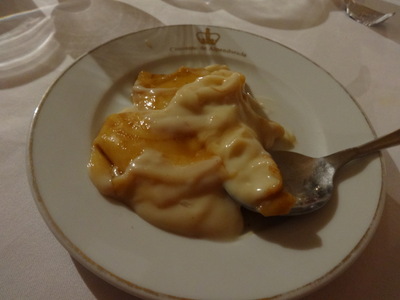 Dessert was a very soft, flan-like caramel custard. Yummy.
Dessert was a very soft, flan-like caramel custard. Yummy.
Then, after more fado and some time to stroll on the terrace to admire the view over the river, it was back on the buses and down the hill to the ship, where we turned in our landing cards (to signify we were back aboard). Others chose to stroll around the village of Bitetos. Still others repaired to the lounge, where Arsenio, the ship's musician, was already providing music for dancing for those who had chosen not to visit the monastary.
Tomorrow, cruising in the morning and excursion in the afternoon . . .